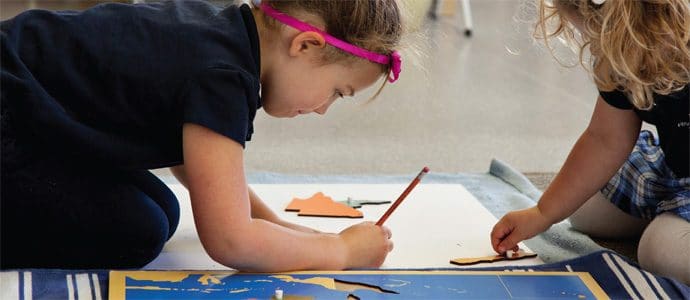Uncategorized
6 min Read
Montessori – still relevant after more than 100 years

August 10, 2016
Uncategorized
6 min Read

August 10, 2016

Italian doctor Maria Montessori studied children all over the world, and observed that they develop in predictable ways. She came to believe that traditional educational practices were lacking.
Montessori developed a child-led curriculum that let children learn at their own pace. The positive results kids achieved in her first Casa del Bambini (‘children’s house’) in a poor area of Rome in 1907 received attention. Her method began to spread throughout Europe.
Montessori caught the eye of Alexander Graham Bell, who opened Canada’s first Montessori school in Baddeck, N.S., in 1912, long before it became popular in the 1960s.
The teacher observes children, then uses specific materials in the classroom – or ‘prepared environment’ – to present lessons to kids who are ready, individually or in small groups. Lessons are given in sequence; children don’t move on to the next lesson until they have mastered the previous one.
Danielle Hourigan, principal of the Montessori school at Hillfield-Strathallan College in Hamilton, Ont., explains how children learn numbers. First, they count out rods, one to 10. “They’re to length, they’re to scale,” says Hourigan. “So they have a sensorial impression of the difference between one and 10.”
Next, numerals are introduced, using sandpaper numbers. “We have them trace them so they’re seeing them, but they’re feeling them in a tactile sense,” says Hourigan. “We’re also giving them the language of what the number is.”
The next step is putting those together by having the child find a rod and the numeral that matches it.
“If kids are really good with this, we take it to a next step,” says Hourigan, using something called the spindle boxes. In the following step, cars and counters, kids set up the sequence themselves.
“As a teacher, it’s diagnostic,” says Hourigan. “You’re seeing they can associate the quantity and symbol. They recognize the numbers, they know how to make a quantity. But we’re having a difficulty here with sequence.” The teacher and student can then review, not moving on to the next lesson until the child understands.
“It sets children up for success,” says Hourigan. “So it’s a challenge, but it’s doable, and it’s not two or three new things. It’s one new thing.”
Once individual students are given a lesson, they can move freely around the classroom, working with classroom materials or followup projects. All work is purposeful.
“They can choose from the activities they’ve been presented with,” says Tiffany Goulding, Head of School at North Star Montessori Elementary in North Vancouver, B.C. “You wouldn’t pull out something you haven’t done before.”
Maggie Volke from River Valley School in Calgary has taught Montessori for more than 30 years. She says ‘child-led’ is a misunderstood term.
“Yes, they do have choices they can make on their own after they’ve been given an initial lesson,” says Volke. “But you don’t see children walking in and going, ‘Hey, I want that’. There is freedom within limits.”
“We’re diving in there right when they’re ready,” Volke says. “If they’re ready at five to learn fractions, we’re going to teach that. If they’re ready at seven, at nine, we’re going to teach it.”
Another Montessori feature is age groupings: one to three for toddlers, three to six for ‘Casa’ or preschool, six to nine and nine to 12 in elementary school. (Infant Montessori programs exist – as well as high school or ‘erdkinder,’ although less commonly.)
The groupings are developmentally appropriate. Older kids build confidence and reinforce their own learning by helping the younger ones, who become inspired.
Kelley Black’s two children are enrolled in the Montessori school at Hillfield-Strathallan. She says she loves that movement is integrated into the curriculum.
“It’s perfect for my son, because it suits his nature. He needs to move.”
“Children need to explore environments in a sensorial way,” says Hourigan. “If you have to go back to the shelf 10 times to get each of the number rods, there’s a lot of movement in that.”
Goulding gives the example of a brain game using movement.
“Once they’ve learned the names of the provinces of Canada, you can put all of the pieces on a table on one side of the room and have the actual map that the pieces would go in on the other side.
“You would say, ‘Bring me British Columbia’. And they would be thinking that they’ve felt that shape in their hand before, they’ve seen that it’s orange, they’ve seen it in the map before. They’re walking across the room thinking, ‘British Columbia, British Columbia, British Columbia.’ They get there, they pick it out, they bring it back and put it in its spot.
“That movement actually builds the brain’s myelin sheath.”
Because children are free to move around the classroom, Goulding says they can also observe lessons being given to other students, spurring their desire to learn and emulate their peers. She says it also helps with managing behaviour.
“The academics are really strong” in Montessori education, says Volke, “but also the social development.”
Part of the curriculum is called ‘grace and courtesy’.
“Children learn to resolve social conflict, supported by the teacher,” says Goulding. “They learn to be respectful of each other.”
Hourigan concurs. “Montessori talked about education as an aid to life. We’re preparing these kids in reference to their life skills and personal qualities, and how those will carry forward.
She says this character development comprises valuable life skills: being responsible and resilient, as well as being able to work in a group, adapt to change, and organize their time.
Parents sure think so. Black says she’s ‘hooked’ on the Montessori approach. Jenny DeVries, mother of a three-year-old (with one on the way), calls sending her son to a Montessori school in Innisfil, Ont. “the best decision we’ve made.”
Find Montessori schools in Canada with ParentsCanada’s Private School Guide.